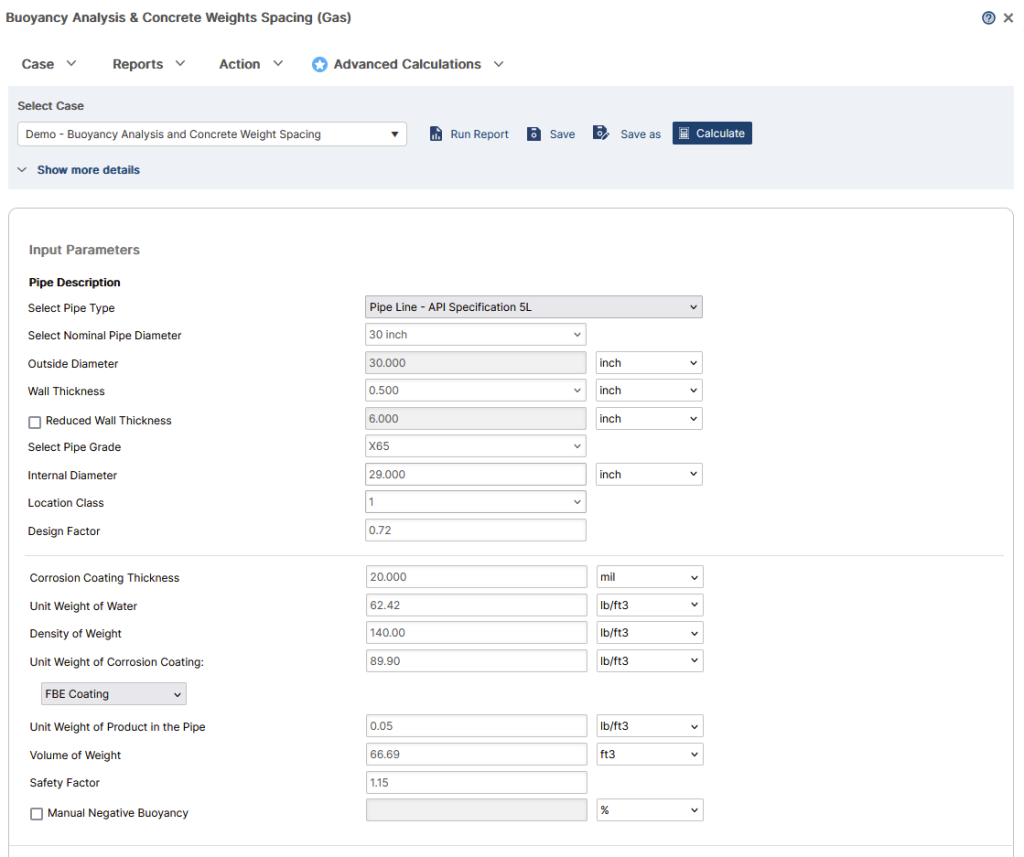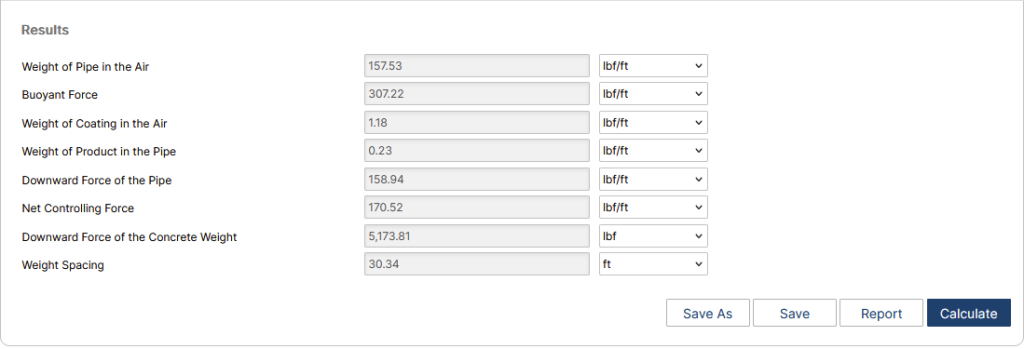Introduction
The Buoyancy Analysis & Concrete Weight Spacing calculator is used to determine the weight spacing needed to keep a pipeline from floating. Supported weights in the calculator are not limited to concrete, and can be constructed of any material, provided the user knows the total mass and volume of each weight.
By default, the calculator determines the weight spacing needed to achieve a zero net buoyancy on the pipe, with a safety factor added for conservatism. Users can also specify the negative percent buoyancy they would like to pipe to have after weights are installed. It is important to note that increasing the safety factor artificially makes the pipe more buoyant for the sake of conservatism; users who who prefer to build their conservatism directly into the negative buoyancy may opt to use a safety factor of 1 to make the results more physical.
Buoyancy Force
We start by calculating the upward buoyancy force on the pipe:
F_B=\frac{\pi}{4}\left(\frac{D_o}{12 [\text{in/ft}]} \right)^2\gamma_w, \text{ where}
F_B=\frac{\pi}{4}\left(\frac{D_o+t_c}{12 [\text{in/ft}]} \right)^2\gamma_w, \text{ where}𝐹𝐵 − Buoyancy Force (lbf/ft)
𝐷𝑜 − Pipe outside diameter (without coating) (in)
tc – Corrosion coating thickness (in)
𝛾𝑤 − Unit weight of fluid/water (lb/ft3)
Weight of Steel Pipe in the Air
Before calculating the weight spacing necessary to oppose the buoyancy force, we first account for all downward forces on the pipe. The weight of the steel pipe in air is given as:
W_P=\pi(D_{o}-t)t \gamma_P, \text{ where}
W_P=\pi(D_{o}-t)t \gamma_{P}, \text{ where}𝑊𝑃 − Weight of bare pipe in air (lbf/ft)
𝐷𝑜 − Pipe outside diameter (without coating) (in)
𝑡 − Pipe wall thickness (in)
𝛾P − Unit weight of steel (3.400 lb/[ft*in2])
Weight of Pipe Coating in the Air
The weight of the pipe coating in air is given as:
W_c= \frac{ \pi(D_o+t_c)t_c}{(12[\text{in/ft}])^2}\gamma_c,\text{ where}
W_c= \frac{ \pi(D_o+t_c)t_c}{(12[\text{in/ft}])^2}\gamma_c,\text{ where}𝑊𝑐 − Weight of coating in air (lbf/ft)
𝐷𝑜 − Pipe outside diameter (without coating) (in)
tc – Corrosion coating thickness (in)
𝛾𝑐 − Unit weight of coating (lb/ft3)
The unit weight of many common corrosion coatings is conveniently accessible underneath the “Unit Weight of Corrosion Coating” dropdown menu. Manual values for the corrosion coating can still be specified.

Weight of Product in the Pipe
The weight of the product in the pipe is given as:
W_{pr}=\frac{\pi}{4} \left( \frac{D_{o}-2t}{12 [\text{in/ft}]} \right)^2 \gamma_{pr}, \text{ where}
W_{pr}=\frac{\pi}{4} \left( \frac{D_{o}-2t}{12 [\text{in/ft}]} \right)^2 \gamma_{pr}, \text{ where}𝑊𝑝𝑟 − Weight of product in pipe (lbf/ft)
𝐷𝑜 − Pipe outside diameter (without coating) (in)
𝑡 − Pipe wall thickness (in)
𝛾𝑝𝑟 − Unit weight of product in pipe (lb/ft3)
Downward Force of the Pipe
Without installing weights, the total downward force on the pipe is the sum of weights given in the previous section:
F_P=W_P+W_c+W_{pr}, \text{where}
F_P=W_P+W_c+W_{pr}, \text{where}F𝑃 − Total downward force on the pipe without weights (lbf/ft)
𝑊𝑃 − Weight of bare pipe in air (lbf/ft)
𝑊𝑐 − Weight of coating in air (lbf/ft)
𝑊𝑝𝑟 − Weight of product in pipe (lbf/ft)
Net Controlling Force
The net controlling force on the pipe is the difference between the buoyancy force, and the downward force on the pipe without weights.
F_{net}=(F_B-F_p)f_s, \text{ where}
F_{net}=(F_B-F_p)f_s, \text{ where}𝐹𝑛𝑒𝑡 − Net controlling force (lbf/ft)
𝐹𝐵 − Buoyancy Force (lbf/ft)
F𝑃 − Total downward force on the pipe without weights (lbf/ft)
fs = Safety Factor
Downward Force of the Weight
The force of an individual weight on the pipe is given as:
F_{wt}=V_{wt}(\gamma_{wt}-\gamma_w), \text{ where}
F_{wt}=V_{wt}(\gamma_{wt}-\gamma_w), \text{ where}Fwt − Downward force of a single weight (lbf)
𝑉𝑤𝑡 − Volume of a single weight (ft3)
𝛾𝑤𝑡 − Unit weight of a single weight (lb/ft3)
𝛾𝑤 − Unit weight of fluid/water (lb/ft3)
Weight Spacing
Once we know the downward force of a single weight, we can calculate the concrete weight spacing necessary to reach the given negative percent buoyancy:
L_{wt}=\frac{1}{f_s}\frac{F_{wt}}{(1+\%b)F_b-F_p}, \text{where}
L_{wt}=\frac{1}{f_s}\frac{F_{wt}}{(1+\%b)F_b-F_p}, \text{where}L𝑤𝑡 − Calculated weight spacing
fs − Safety factor
%b − Negative percent buoyancy (defaulted to 0%)
𝐹wt − Downward force of a single weight (lbf)
𝐹𝐵 − Buoyancy Force (lbf/ft)
F𝑃 − Total downward force on the pipe without weights (lbf/ft)

Case Guide
Part 1: Create Case
- Select the Buoyancy Analysis & Concrete Weight Spacing application from the Design & Stress Analysis Module
- To create a new case, click the “Add Case” button
- Enter Case Name, Location, Date and any necessary notes.
- Fill out all required Parameters.
- Make sure the values you are inputting are in the correct units.
- Click the CALCULATE button to overview results.
Input Parameters
- Nominal Pipe Diameter (in): (0.625” – 48”)
- Wall Thickness (in): (0.068” – 2”)
- Reduced Wall Thickness (in): (0.068” – 2”)
- Pipe Grade
- Internal Pipe Diameter (in): (0.49” – 46”)
- Location Class
- Design Factor
- Corrosion Coating Thickness (in): (1 mil – 50 mils)
- Unit Weight of Water: (59 – 64) (lbs/ft3)
- Density of Weight: (90 – 150) (lbs/ft3)
- Unit Weight of Corrosion Coating: (50 – 100) (lbs/ft3)
- Unit Weight of Product in the Pipe: (50-100) (lbs/ft3)
- Volume of Weight (ft3)
- Safety Factor
- Manual Negative Buoyancy – Defaulted to 0, if value not entered

Part 2: Outputs/Reports
- If you need to modify an input parameter, click the CALCULATE button after the change.
- To SAVE, fill out all required case details then click the SAVE button.
- To rename an existing file, click the SAVE As button. Provide all case info then click SAVE.
- To generate a REPORT, click the REPORT button.
- The user may export the Case/Report by clicking the Export to Excel icon.
- To delete a case, click the DELETE icon near the top of the widget.
Results
- Weight of Pipe in Air: (21 – 1750) (lbf/ft)
- Buoyancy Force (lbf/ft)
- Weight of Coating in Air (lbf/ft)
- Weight of Product in Pipe (lbf/ft)
- Downward Force of the Pipe (lbf/ft)
- Net Controlling Force: (-4 – 255) (lbf/ft)
- Downward Force of the Weight (lbf)
- Weight Spacing (ft)


References
- ASME B31.8 – Gas Transmission and Distribution Piping Systems
- API 5L, API 5LS and API 5LX – Specification of Pipe Grade
- ASTM – Various – Weld Joint Factor
- CFR Code Part 192
- MMS Regulations
- USDA-SCS Modified (Permissible Velocity of Water and Soil Erodibility)
- FHWA-HEC
- Pipeline Rules of Thumb Handbook
FAQ
-
Restrained versus Unrestrained Pipe (Difference in Gas vs. Liquid)?
ASME B31.4 liquid and B31.8 gas codes include calculations for the net longitudinal compressive stress that must be applied only for a restrained line that equates to a low (less than 2%) longitudinal strain. This stress status is characteristic to underground pipelines located some distance away from above ground piping facilities.
Unrestrained lines means those above ground sections of piping without axial restraint as with buried pipe with soil. In others words the soil exerts substantial axial restraint, but not fully restrained. Check Out
-
What is the Maximum Span Length of rev1?
Regarding span factors with and without water are based on bending stress and deflection. Larger diameter pipe spans require saddles for stability. Many standards that require pipes to be filled with water are based on bending and shear stresses not to exceed 1,500 psi and a deflection between supports not exceed 0.1 inches. Check Out
-
What is the model used for Thrust at Blow-Off?
